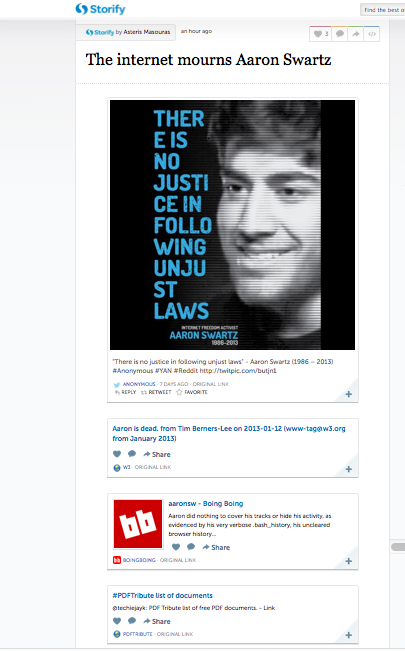The digital age has brought us millions of new online services and apps to help us share information and be more connected. One of these services, Storify, relates specifically to connecting communities of interest across multiple social networking sites. It’s a good way to get a snapshot look at what people are posting about a certain topic on social media, or to compile your own thoughts on a topic across sites.
 According to its website, Storify “helps
According to its website, Storify “helps
These stories can be created on any topic: bloggers and citizen journalists report on recent news items, companies share their events and conferences, and people just have fun with topics they’re interested in and personal social media conversations.
Storify is also used by news outlets as a way to capture a mixture of responses to breaking news. What are people saying about Lance Armstrong’s confession? How do people feel about the Manti Te’o scandal? News outlets are even creating fun stories about topics relevant to their readers: Snow Hits the UK: Twitter Reaction. Some of the news outlets using Storify include ABC News, CNN iReport, The Washington Post, The Guardian, and CBC News.
In an effort to switch from primarily being a tool to create content to becoming a content discovery platform, Storify’s website features various stories on top news items, which are also tweeted and posted to Facebook.
Each user of Storify has a page (these resemble a mash-up of numerous social networking pages). In addition to the stories they have created, users can list their websites and Twitter handles on their page. The “Follow” button allows those interested to see updates in their feed. Each story can be “liked” or commented on and shared to other social network sites. A good example of a story on an individual user’s page is photojournalist Asteris Mouseras’ story collecting reactions to the suicide of activist Aaron Swartz.
While I wouldn’t personally use Storify to build yet another social media presence, I love looking through the stories others have made. Businesses could leverage this resource to keep their customers informed and report on special events — or as our PR team does for clients — to capture highlights of a campaign or series of customer interactions for sharing internally. The fact that these story pages can be shared on websites and via social media increases their usefulness. Check it out for yourself – and see if it could be useful for your business.




Storify: Building Multimedia Stories Across Boundaries | Change Conversations http://t.co/2AnLvUFi